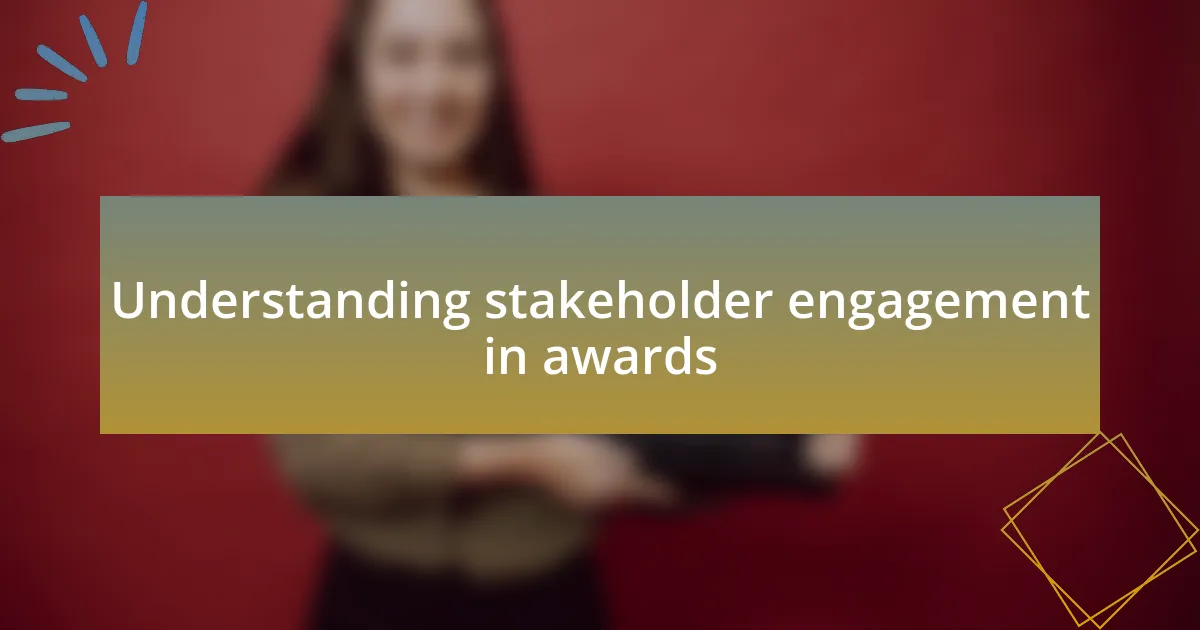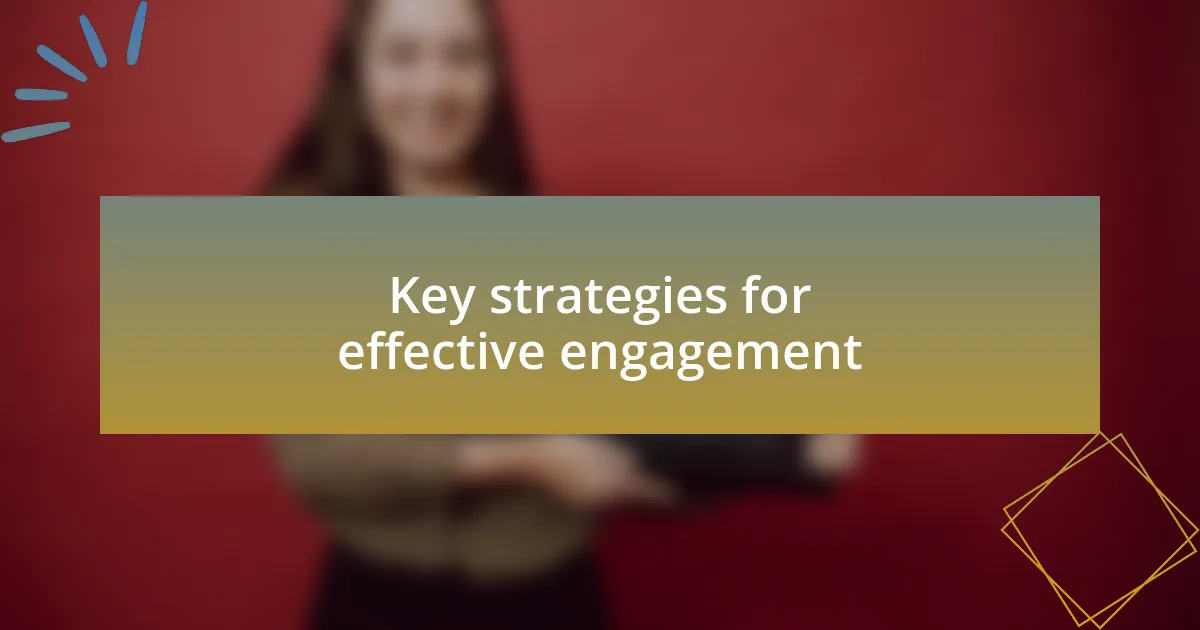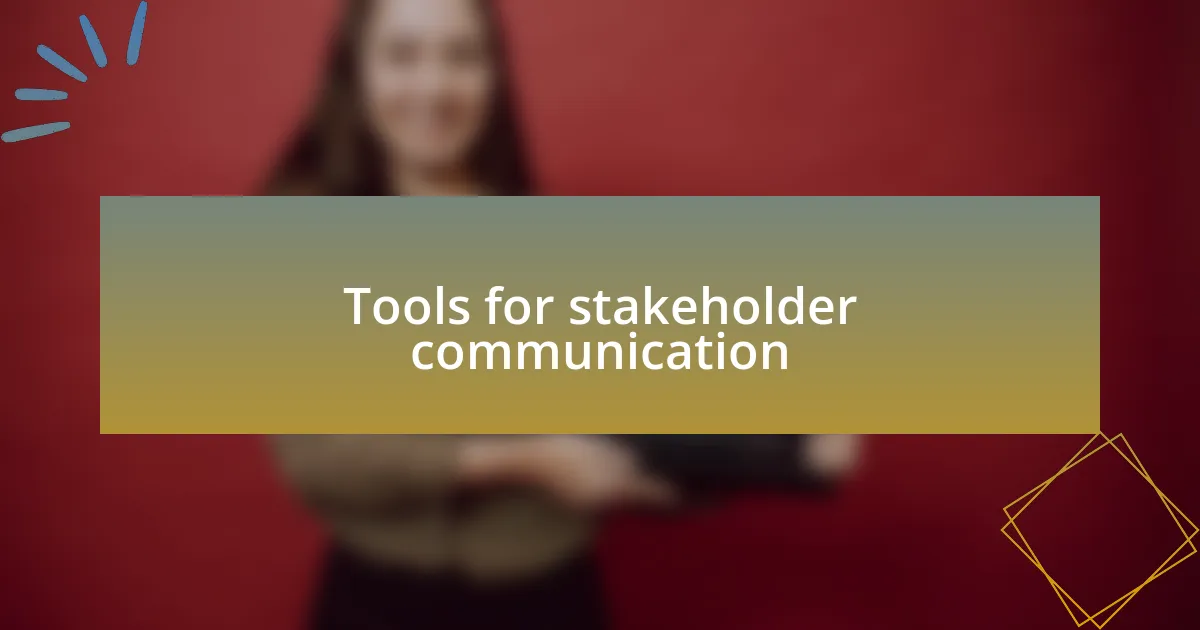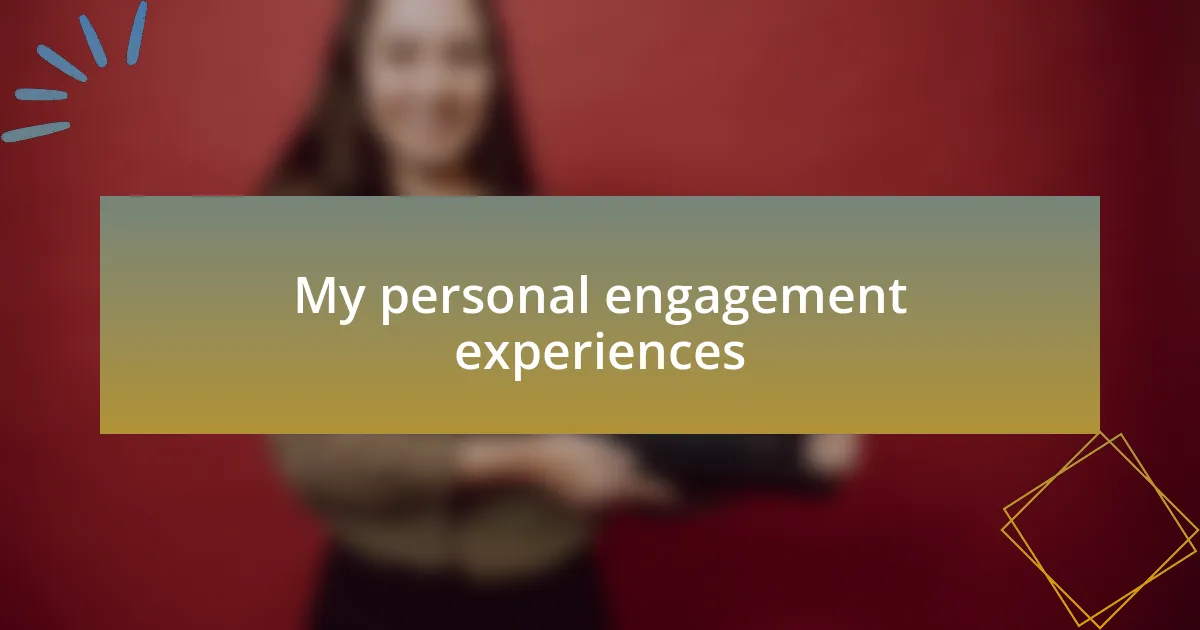Key takeaways:
- Effective stakeholder engagement creates emotional connections, enhancing the overall experience of awards by recognizing individual contributions and fostering a sense of community.
- Active listening and transparency are crucial strategies that build trust and ownership among stakeholders, making them feel invested in the event’s success.
- Utilizing diverse communication tools and methods, including in-person meetings and digital platforms, fosters creativity and deeper relationships among participants.
- Post-event follow-ups and clear objectives help maintain engagement, nurture relationships, and encourage ongoing collaboration for future events.

Understanding stakeholder engagement in awards
Stakeholder engagement in awards is not just a procedural requirement; it’s an emotional journey for everyone involved. I recall a particular moment when I realized how vital this engagement was. During a music awards event, I saw the sheer joy in an artist’s eyes as she shared her story with the audience, reminding me that every nomination signifies countless hours of hard work and passion.
Building relationships with stakeholders requires an understanding of their unique perspectives and motivations. Have you ever thought about what drives a sponsor’s commitment to an event? For me, it became clear that aligning their values with the mission of the awards creates a richer experience, fostering a sense of community that extends beyond just the event.
Deep engagement goes beyond mere communication; it’s about creating a shared narrative. I remember collaborating with diverse groups, including artists, fans, and judges. Each conversation offered a new lens through which to understand the essence of the awards, shaping everything from the selection process to the event itself, and reinforcing the shared love for music that brought everyone together.

Key strategies for effective engagement
Key strategies for effective engagement involve actively listening to your stakeholders. I remember sitting down with a group of fans during a planning session for a music awards show. Their feedback helped us shape the event’s flow and lineup in ways I never anticipated. I learned that their passion could truly guide decision-making, creating a sense of ownership that makes them feel invested in the event’s success.
Another essential strategy is fostering transparency throughout the engagement process. I’ve found that being open about our decisions, whether they pertain to nominees or event logistics, builds trust. When I openly shared the reasoning behind our choices, it not only alleviated concerns but also encouraged stakeholders to see themselves as part of a collaborative team rather than mere participants.
By seamlessly integrating stakeholder perspectives into the awards process, I ensure everyone feels valued. One particular year, we invited artists to participate in selecting nominees. Watching their enthusiasm and collective creativity was enlightening. It struck me that when our stakeholders see their contributions reflected in the final output, it elevates the entire experience, turning the awards into a celebration that belongs to everyone involved.

Tools for stakeholder communication
When it comes to effective stakeholder communication, I’ve found that using a mix of digital tools can be transformative. For instance, during the planning stages of a recent awards show, we utilized project management software to keep everyone on the same page. This tool not only organized tasks but also allowed stakeholders to comment on specific aspects, creating a sense of unity and shared purpose. Have you ever felt more connected to a project when you could see your input make a difference?
Email newsletters have also proven invaluable in my experience. I crafted regular updates for our partners—artists, sponsors, and fans alike—that included sneak peeks of the event planning process. This ongoing communication not only makes stakeholders feel included but also generates excitement. It’s amazing how a simple update can turn passive observers into engaged advocates for the event.
Of course, in-person meetings still hold a special place in my heart. I recall a gathering with local community leaders where we discussed how the awards could reflect their culture. The energy in the room was palpable, and the ideas that emerged felt so much richer than anything that could come from a screen. There’s something about face-to-face interactions that fosters creativity and deepens relationships—have you ever experienced that magic?

My personal engagement experiences
My engagement experiences have often been shaped by the stories shared by the artists themselves. I remember an occasion when a singer spoke candidly about their journey and struggles during a roundtable discussion. Hearing their raw emotions stirred something in me, emphasizing the importance of authenticity. Isn’t it fascinating how personal stories can create an emotional investment in an event?
I’ve also discovered the power of small, informal gatherings. One memorable evening, we hosted a small dinner for key stakeholders where the atmosphere was relaxed and open. This setting encouraged genuine conversations, allowing everyone to share their thoughts freely. It struck me how these moments fostered more profound connections and shared visions for the awards. Have you ever noticed how breaking bread can break down barriers?
Lastly, I’ve found that following up with stakeholders after events is crucial for ongoing engagement. After our last award show, I sent personalized notes to each sponsor, thanking them for their support. The responses were heartfelt, with many expressing their appreciation for the acknowledgement. This simple practice not only nurtured relationships but also laid the groundwork for future collaborations. Isn’t it incredible how small gestures can yield big returns in relationship-building?

Lessons learned from stakeholder interactions
Lessons learned from stakeholder interactions
One significant takeaway from my interactions with stakeholders is the value of active listening. During a panel discussion, a sponsor shared unexpected insights about their brand values that resonated deeply with our audience. I realized how crucial it is to genuinely hear what others are saying, as it creates the foundation for more tailored strategies that resonate with everyone involved. Have you ever found that listening can open doors to new opportunities?
Another lesson came during a feedback session post-event. I was taken aback by how much stakeholders appreciated the chance to voice their opinions. One suggestion led us to revamp our voting process, making it more transparent and engaging. It hit me then that fostering an environment where they felt valued made them more invested in the success of the event. Have you experienced how feedback can turn ideas into actions?
Lastly, I’ve learned that adaptability is key. There was a moment when a major partner had to pull out last minute, and instead of panicking, we turned it into an opportunity to collaborate with a local artist. The response from the community was overwhelmingly positive, and it dawned on me that embracing change can lead to unexpected successes. How many times have you turned a setback into a stepping stone?

Best practices for future engagements
When planning future stakeholder engagements, I’ve found that setting clear objectives is essential. During a previous awards ceremony, we identified specific goals for collaboration, which helped align everyone’s expectations. Did you ever notice how clarity can transform a conversation into a productive partnership?
Another effective practice is to prioritize follow-ups. After an engagement, I make it a point to reach out to stakeholders, thanking them for their contributions and sharing how we plan to use their input. This simple act not only strengthens relationships but also fosters a sense of ownership and commitment among everyone involved. Have you seen how a little gratitude can go a long way in building rapport?
Incorporating diverse communication channels has proven invaluable as well. For example, last season, we hosted virtual roundtables alongside traditional meetings, allowing more stakeholders to participate. The varied perspectives gained from this approach opened avenues for innovation that we may have otherwise overlooked. How often do you find that mixing methods leads to richer discussions?